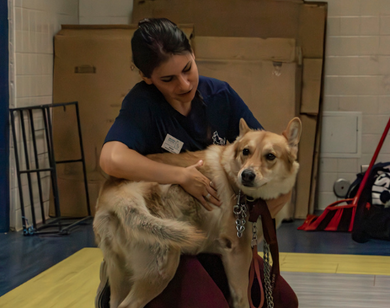Looking for fun activities for your kids while you're at home? Here is a great lesson to help them learn more about their pets at home and themselves, while using science and math!
Practicing Getting a Heart rate
A friendly pet who enjoys attention and petting can be a great helper for this but no worries if your pet isn’t up to the task- a parent or guardian can lend a hand and act as the “patient” here!
How to find the pulse: https://www.cardiosmart.org/~/media/Documents/Fact%20Sheets/en/zu1592.ashx
What is one of the first things that gets checked when visiting the doctor? The heart!
And the same is true when you take your pet to the veterinarian.
Yes, your doctor or veterinarian wants to know that you or your pet’s heart is beating- but why?
The heart is in charge of delivering blood to every part of the body and blood is in charge of carrying the oxygen that is necessary for cellular life throughout the body. The heart must beat at the right speed to deliver blood needed all the way to the toes and back- whether the toes are furry, scaly or covered in feathers!
Your doctor or veterinarian will listen to the heart and get a heart rate. The heart rate is how many times each minute the heart beats.
There is not one perfect speed for the heart to beat- the heart rate is dependent on a lot of factors such as age, overall health, recent activity, and even how nervous the patient might be during examination!
To practice getting heart rate on your pet, all you need is:
- Your hands
- A clock with a second hand or a timer/stopwatch
- A parent/guardian
- A friendly and willing pet who enjoys being pet
First, let’s find where to find the heart on your pet:

While your pet is laying on his/her side, you can lay your hand on his/her chest, close to where his/her elbow touches his ribcage. If your pet is comfortable with you touching him/her on the side and is happily receiving attention from you, you should be able to feel the heartbeat here. If you are unable to feel the heartbeat here, you may be able to feel it more easily on the side of your pet that is touching the floor.
Once you feel the heartbeat, ask your parent or guardian to get ready to start their stopwatch for thirty seconds. When the timer starts, begin counting heartbeats for thirty seconds!
Repeat two more times, make a chart and write the number of heartbeats down for each try. Add a column so you can multiply each number by 2.
Your chart should look like this:
|
# of heartbeats |
Multiplied by 2 |
|
|
1st try |
|
|
|
2nd try |
|
|
|
3rd try |
|
|
By multiplying the number of heartbeats you heard (in 30 seconds) it’s as if you listened for 60 seconds or one whole minute!
The number in your second column is considered the heart rate.
Remember, there is not one perfect number to look for when finding a heart rate, however, a normal resting heart rate for a dog can range from 60 - 120 for dogs and 150 – 200 for cats, depending on age, size, activity and other factors.
So if you first heard 60, then 58 and then 61 heartbeats the third time, your chart would look like this:
|
# of heartbeats |
Multiplied by 2 |
|
|
1st try |
60 |
120 |
|
2nd try |
58 |
116 |
|
3rd try |
61 |
122 |
Ready for another challenge?
If you feel for the heart rate for 15 seconds, what number would you need to multiply by in order to know how many times the heart beats every minute?
How would that be written mathematically?
15 times What = 60 seconds?
15X = 60
15X/15 = 60/15
X=4
Make a new graph – It should look like this
|
# HB |
x4 |
|
|
1st try |
|
|
|
2nd try |
|
|
|
3rd try |
|
|
Is it easier or harder to get the heart rate for 15 seconds? Why or why not?
Now feel for your pet’s heart rate once again and write down the numbers you get. Do this three times and fill in your chart. Are your numbers similar to the ones from your first chart?
Ready for a final challenge?
If you feel for the heart rate for 6 seconds, what number would you need to multiply by in order to know how many times the heart beats every minute?
How would that be written mathematically?
6 times What = 60 seconds?
6X = 60
6X/6 = 60/6
X=10
Make your chart again
|
#HB |
x10 |
|
|
1st try |
|
|
|
2nd try |
|
|
|
3rd try |
|
|
Your chart may look something like this now:
|
#HB |
x10 |
|
|
1st try |
12 |
120 |
|
2nd try |
11 |
110 |
|
3rd try |
12 |
120 |
Now compare all of your heart rates.
What are some of the differences you see between the different charts?
Can you find an average from each chart?
To find the average, add all of the number and then divide that sum by how many numbers you added together (3).
For example, to find the average of the last try, add 120, 110 and 120 then divide by 3.
120 + 110 + 120 =350
350/3 = 116.666
Now find the averages for the other two attempts- which do you think is the most accurate?
Why do you think that is?
Final challenge….
Get your pet up and play his/her favorite active game for a few minutes then try to get a heart rate.
Do you think this activity will affect your pet’s heart rate?
If so, in what way?
Why?
Repeat the steps above, gathering more data.
Create a graph to chart all of your data-
What does your chart look like?
|
30 seconds |
|||
|
#HB |
x2 |
||
|
1st try |
60 |
120 |
|
|
2nd try |
63 |
126 |
|
|
3rd try |
58 |
116 |
|
|
|
|
|
|
|
15 seconds |
|||
|
|
|
||
|
# HB |
x4 |
||
|
1st try |
|
|
|
|
2nd try |
|
|
|
|
3rd try |
|
|
|
|
|
|
|
|
|
6 seconds |
|||
|
#HB |
x10 |
||
|
1st try |
|
|
|
|
2nd try |
|
|
|
|
3rd try |
|
|
|






